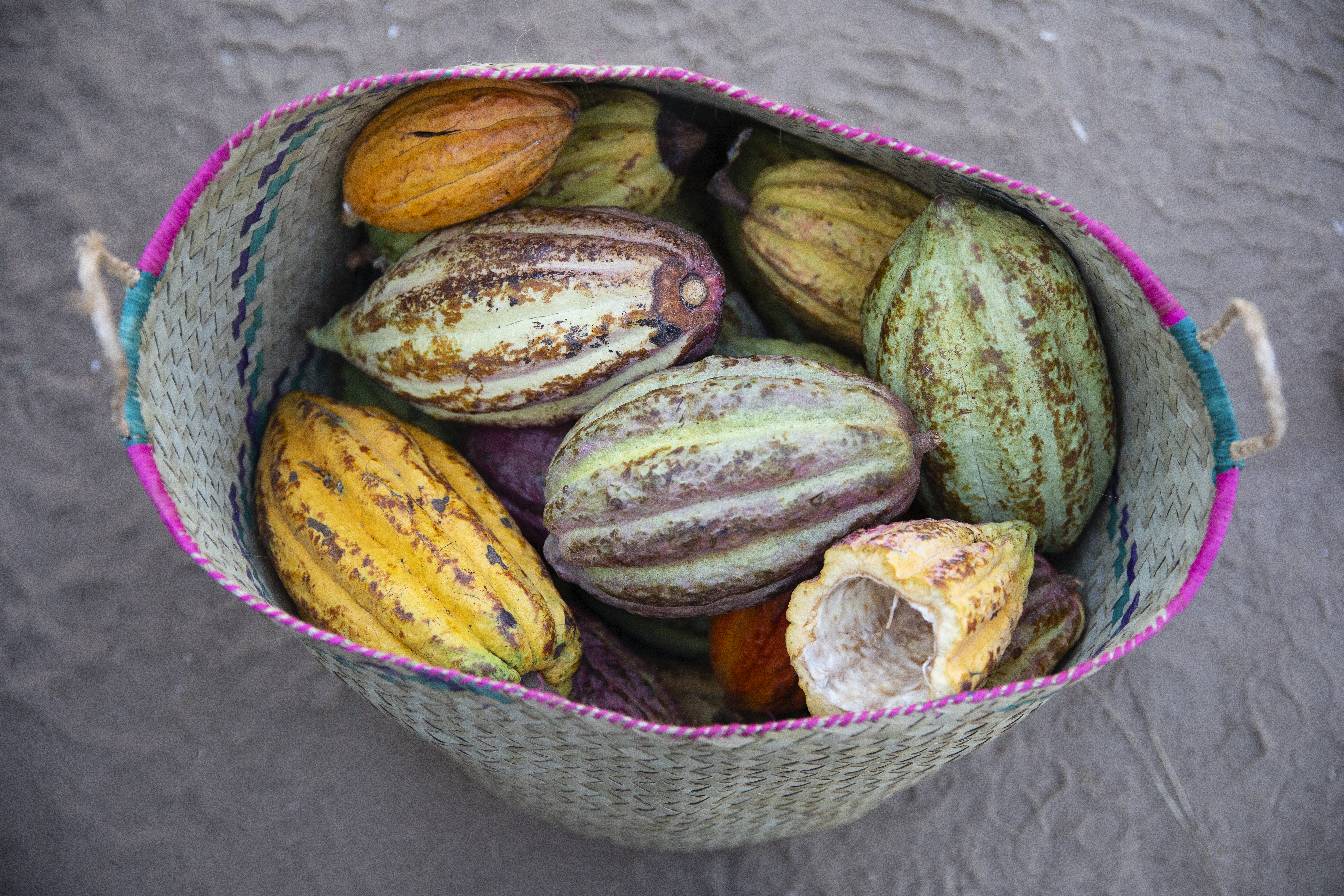
How the Swiss help Madagascar’s cacao farmers confront climate change

Madagascar is a key front line in the battle against climate change. It’s crucial for the future of Swiss chocolate, and the industry knows it.
On this tropical island in the Indian Ocean, the Sambirano River is flanked by aromatic Madagascar cacao trees and the small plots of local farmers. Lately, keeping those trees alive – and harvesting the high-end beans they provide to Swiss consumers – has become more and more difficult. A Swiss-led project is working to mitigate the threat climate change poses to the region, keeping a vital supply line open for the Swiss chocolate industry.
“I have cacao trees that dry out and die from the heat. It’s as if they were burnt,” says cacao farmer Hugues as he manoeuvres a picking pole to pluck ripe cacao fruits from the treetops.
The rainy season, which normally runs from November to April, has become shorter and more intense. Madagascar is vulnerable to powerful cyclones, which have become more frequent and powerful. These storms have redrawn the course of the Sambirano River, causing widespread flooding and washing away cocoa plots along the riverbank. The rainfall in February was brutal.
“If it’s not the heat that kills them, it’s the water,” sighs Hugues, pushing deeper into the fields.
Hugues is among thousands of farmers growing cacao in the Sambirano Valley, home to Madagascar’s most fertile cocoa land. The region is a focal point for international projects blending conservation and agriculture. One such effort addressing land degradation and deforestation is the Climate-Resilient Cocoa Landscapes project, implemented by Swiss-based NGO Helvetas with support of the Swiss Platform for Sustainable Cocoa, an eclectic alliance involving the chocolate manufacturers, traders, retailers, NGOs, research institutions and government officials.
The Sambirano River appears calm as children splash and guide skinny zebu, a type of humped cattle, across it. But shredded riverbanks hint at the devastating effect of flooding. Entire cacao fields have been washed away during the rainy season. This is one area where locals, with the support of Swiss partners, are trying to confront the problem by drawing on nature-based solutions.
Madagascar’s high-quality cacao: a premium choice for Swiss chocolate
Madagascar’s cacao beans are a mark of quality. “The bean of Madagascar is exceptional in its taste,” says Joël Frei of the Swiss Platform for Sustainable Cocoa. “In Switzerland, we are very used to chocolate made from beans that come from Ghana or the Ivory Coast, which are also of very good quality. Malagasy cocoa beans have a coffee-like or slightly bitter taste. They are fruitier and more complex. It really makes a difference to the taste.”
Madagascar’s cacao claim to fame is quality, not quantity. With an output of 12-15,000 tonnes of cocoa per year, the African nation is a tiny player compared to Africa’s heavyweights, Ghana and Ivory Coast, which together account for 50% of the world’s cocoa. Switzerland imported almost 1,000 tonnes of cacao beans from Madagascar in 2023, a below-average year, having typically imported 1,500 to 2,000 tonnes per year in the past decade.
Despite its modest output, Madagascar-origin cacao is widely associated with excellence. It is proudly advertised in the chocolate bars of Swiss companies, many of which source from the Sambirano Valley and support the Helvetas project there, as does the Swiss State Secretariat for Economic Affairs (SECO) via the Swiss Platform for Sustainable Cocoa.
Frei says that the project implemented by Helvetas is promising because it involves a wide range of people along the cacao supply chain. The NGO coordinates this project that brings together public, private, and local entities to protect and restore the valley’s ecosystems, which have been badly damaged by slash-and-burn agriculture, fuelwood-driven deforestation and the effects of climate change.
Felchlin, a leading producer of fine Swiss chocolate couvertures and semi-finished products, supports the project and follows it closely. It has three top-range couvertures featuring the fruity notes of Madagascar’s cacao.
“The cacao from the Sambirano region is one of our direct sourced noble cacaos,” says Mirko Schneckenburger, head of marketing and communications at Felchlin, which has headquarters in central Switzerland and is business-to-business oriented. “Our customers are chocolatiers, bakeries, confectioners. The premium segment of gastronomy all over the world.”
Manual matchmaking: cacao pollination now done by hand
Bird song and the crow of roosters fill the air as farmers scan trees for plump cocoa pods ready to be picked near the town of Ambanja. Florica Malalanirina is more interested in finding viable blooms, so pale they are barely visible in the shade cast by interlaced treetops. Climate change in the region is taking a toll on insects involved in the pollination process and has ushered in new diseases.
“We turn to manual pollination to boost the yield of cacao trees,” explains Malalanirina, an agronomic technician who grew up with the sweet scent of sugar cane grown by her parents in the northern town of Ambilobe. She works for Felchlin’s supplier in Madagascar, Sambirano S.A. “Climate change has had an impact on pollination because many of the insects involved in that process die from the heat.”

Typically, cacao flowers rely on tiny midges – small flies found in tropical regions – to pollinate them. To compensate for the weakened role of mother nature’s matchmakers, Malagasy cacao growers are now carrying out the process by hand.
Malalanirina uses a tiny brush to collect pollen from one tree and apply it to a different flower on a different tree. The unique structure of the cacao flower presents challenges for natural pollination, as the flower’s delicate, complex shape makes it difficult for pollen to reach the pistil, or female part, where fertilisation occurs.
Veronique Volohisoko has been growing cacao since 2004. It remains a family effort, although the productivity of their 200 trees is on the decline. “Cacao trees used to have a huge yield; now it is less and less,” says the mother of one, blaming alternatingly harsh spells of heat and excess humidity for this season’s relatively modest yield of 70 kilos.
Madagascar’s cacao farmers fight erosion, embrace fertilisers
The road to the villages high in the Sambirano region is unpaved and rough. Cars break down even in dry weather. Along the way, the inverted teardrop shapes of Madagascar’s lavakas stand out. These erosion gullies are formed when groundwater destabilises steep slopes, causing soil collapse. Although they have always occurred, factors like deforestation and intensified rain and drought cycles due to climate change have worsened lavaka formation.
“The valley’s rivers bring down erosion from the highlands, filling our fields with sandy, infertile soil,” explains Raymond Mandiny, the president of the watershed committee. “Cocoa doesn’t grow well in sandy soil, so we’re constantly fighting to reclaim the black earth needed for cocoa.”
Without intervention, experts predict continued degradation of the land, which will in turn threaten the supply of Madagascar’s unique, high-quality cocoa, as well as the livelihoods of some 30,000 farmers. To counter this, cacao farmers are also planting trees to reforest the erosion-prone, steep slopes of the region.
Organic fertilisers are also becoming crucial to the cocoa plants’ success in the increasingly fragile growing environment. The landscape project is working to help farmers embrace them.
“This isn’t just about farming practices; it’s a mindset change,” says Michel Razafindrabe, project officer for the climate-resilient cocoa initiative of Helvetas. “Before, farmers didn’t use fertilisers at all. Now, we’re showing them how to use organic ingredients.”
Market demands clash with local realities
Sustainable practices can be a tough sales pitch to farmers whose priority is putting food on the table. The poverty rate in rural Madagascar is estimated to be around 80%, and the average income is often less than $2 per day, leaving families vulnerable to economic shocks. Local leaders say other challenges can feel more pressing, such as lack of technical support, isolation due to poor road conditions, and the fluctuation of cacao prices.
But the European market is demanding deforestation-free products, with EU regulations requiring deforestation-free certification for cocoa and other commodities from 2026. That requires tracing cacao back to specific plots of land. The Swiss-led project in the region is therefore helping smallholders secure land titles and collect geographic coordinates of the cocoa plots, essential steps in meeting EU demands.
It’s difficult to get everyone on board. “Some see reforestation as a land grab, and part of our role is explaining that these efforts are not to take land away, but to protect it for future generations,” explains Razafinrabe of Helvetas.
But despite the uphill battle, Arona, mayor of the Ambohitrandriana Commune, sees hopeful signs.
“In just one year, our reforestation has reduced sand in the river,” he says. “People are beginning to understand the importance of this work. The Swiss see our drive to protect the environment, and we are motivated by that.”
Edited by Veronica De Vore/sb

More
Newsletters

In compliance with the JTI standards
More: SWI swissinfo.ch certified by the Journalism Trust Initiative










































You can find an overview of ongoing debates with our journalists here . Please join us!
If you want to start a conversation about a topic raised in this article or want to report factual errors, email us at english@swissinfo.ch.